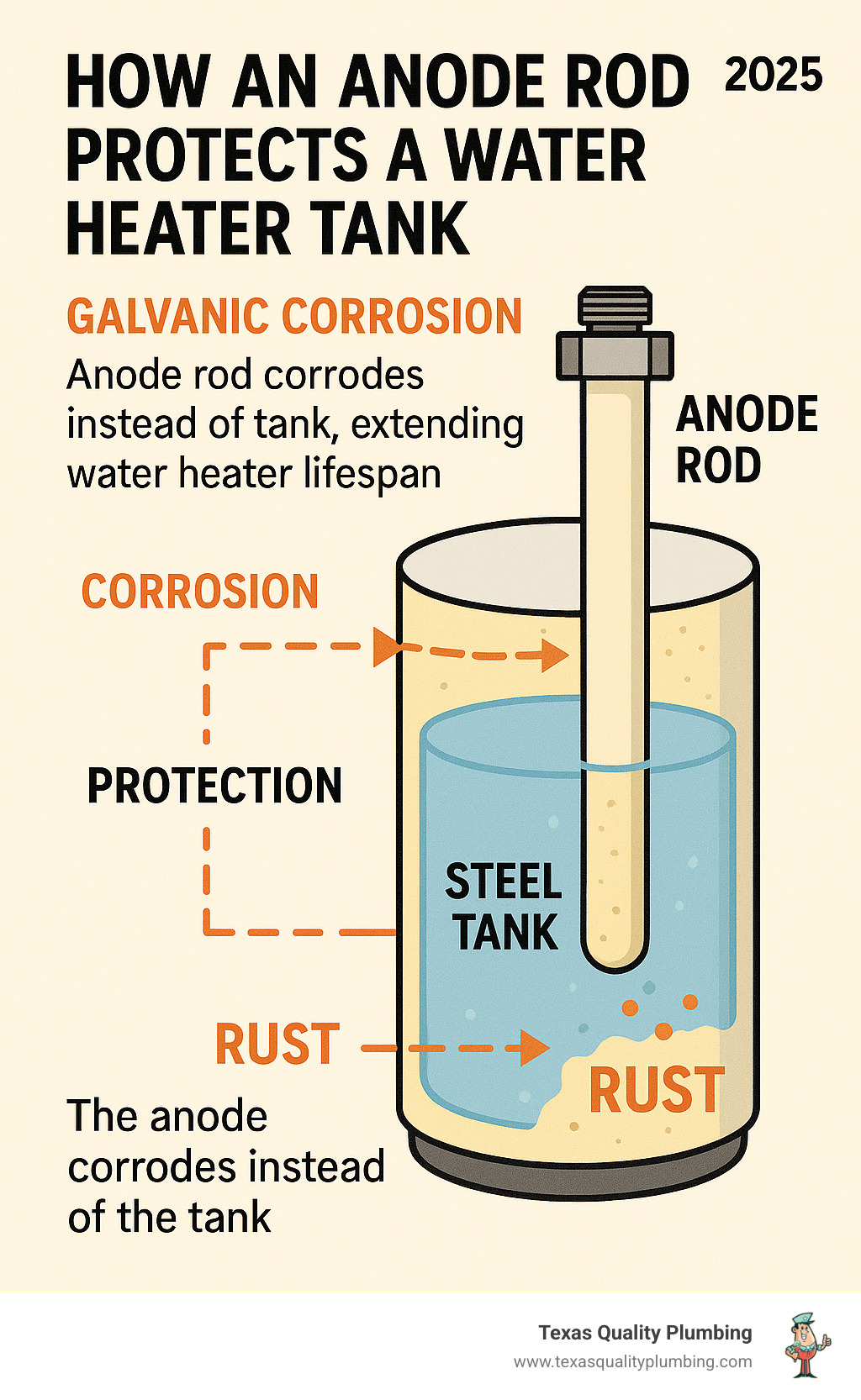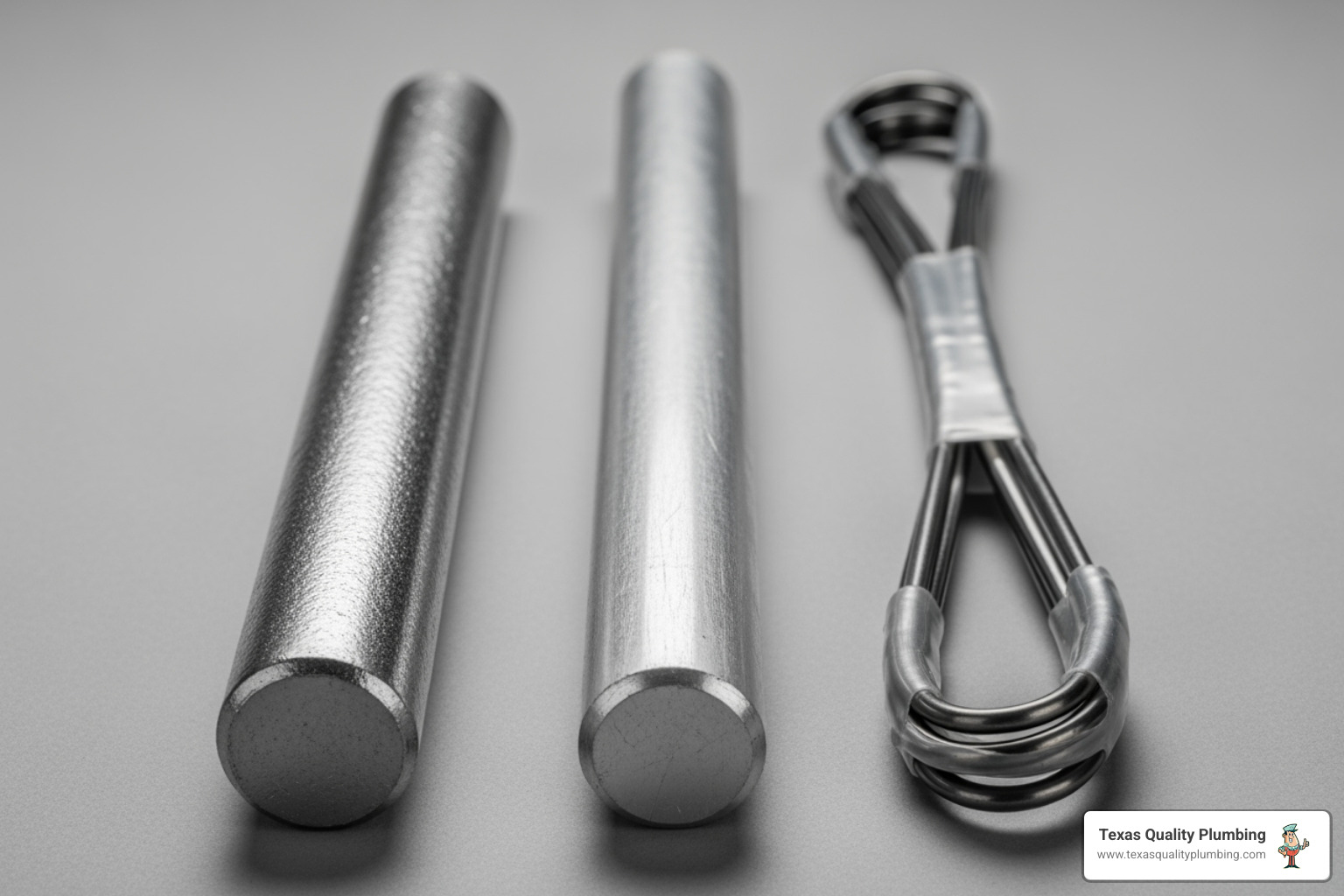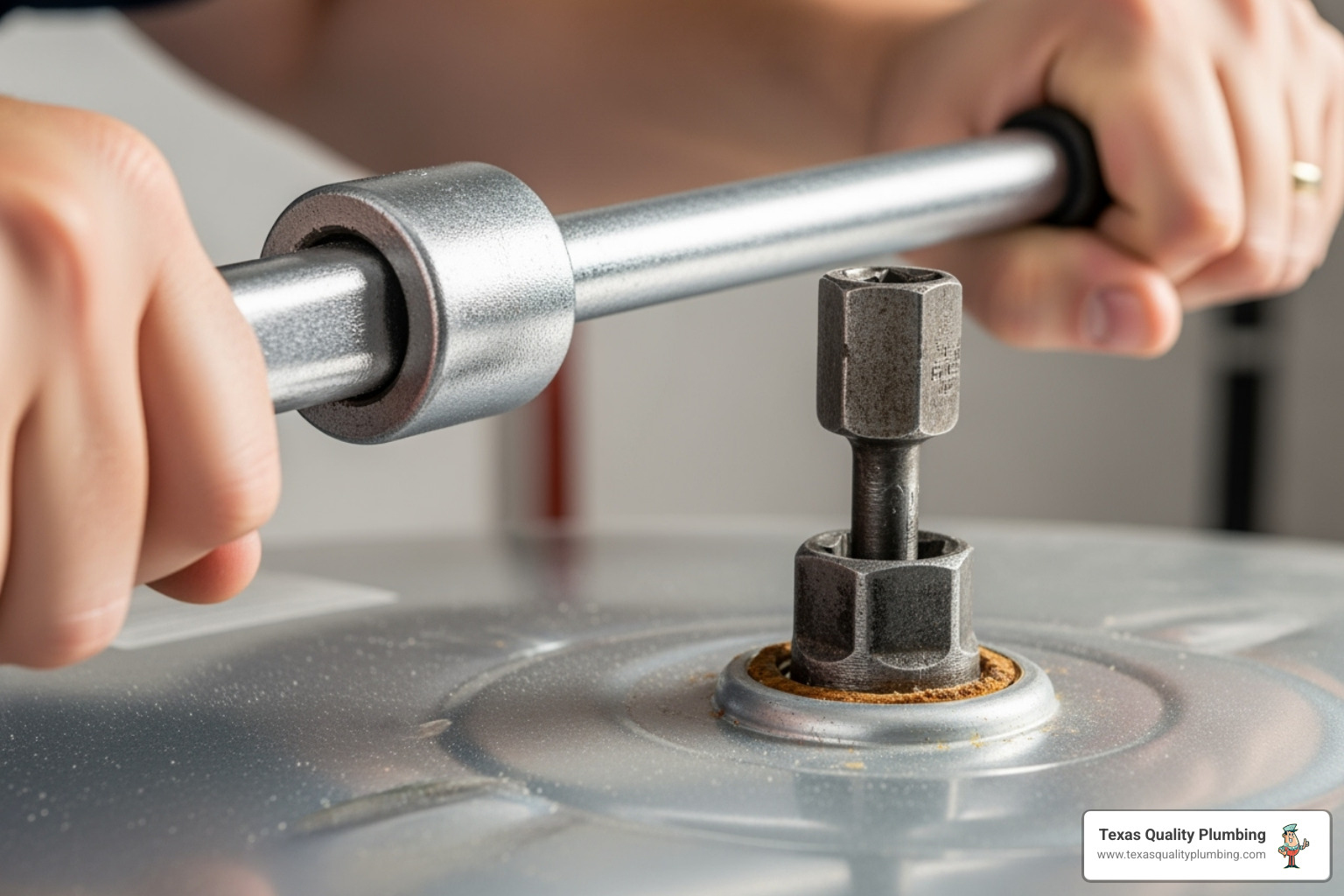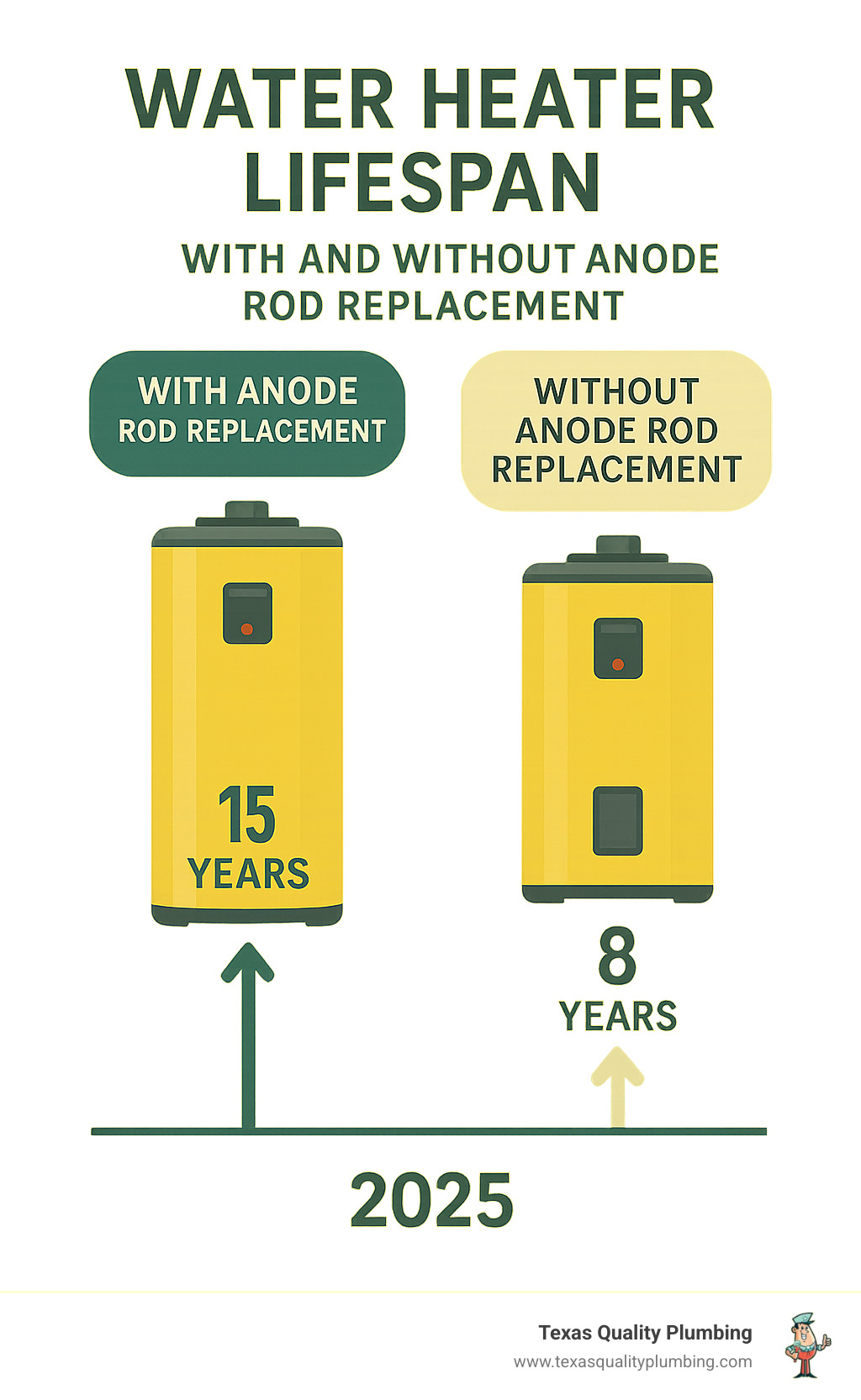The Unsung Hero Inside Your Water Heater
Anode rod replacement might sound like plumber jargon, but it’s actually one of the smartest investments you can make for your home. This simple maintenance task can extend your water heater’s life by 5-10 years and save you thousands in premature replacement costs.
Quick Answer: How to Replace an Anode Rod
- Turn off power/gas and water supply
- Drain 2-5 gallons from the tank
- Locate the anode rod (usually on top under a plastic cap)
- Remove old rod with 1-1/16″ socket and breaker bar
- Install new rod with Teflon tape on threads
- Refill tank and restore power
Your water heater’s anode rod is a sacrificial component—a sacrificial anode designed to corrode so your expensive steel tank doesn’t. It protects the tank through the principles of galvanic corrosion. Made from magnesium, aluminum, or zinc, this metal rod attracts all the corrosive elements in your water.
Without a functioning anode rod, your water heater tank will rust from the inside out. The result? Premature failure, costly leaks, and the hassle of emergency replacement.
Most homeowners have no idea this component exists until their water starts smelling like rotten eggs or their tank springs a leak. But here’s the thing – checking your anode rod yearly and replacing it every 3-5 years is way easier than dealing with a flooded basement and a hefty replacement bill.
Why and When to Replace Your Anode Rod
Your water heater works 24/7, but it’s under constant attack. Every gallon of water carries minerals and corrosive elements that can turn your expensive steel tank into a rusty mess.
This is why anode rod replacement is so important. The anode rod acts as a bodyguard for your water heater, taking the corrosive punishment so your tank doesn’t have to. It sacrifices itself to prevent the inevitable corrosion that occurs when hot water and oxygen meet steel.
Regular replacement can extend a typical 8-10 year lifespan to 15-20 years. Compared to the cost of a new water heater, making anode rod replacement part of your home maintenance routine is a smart financial decision.
The best part? Catching this early prevents nightmare scenarios like a flooded basement or an ice-cold shower when your tank finally fails.
Signs Your Anode Rod is Failing
Your water heater will give you warning signs when something is wrong. You just need to know what to look, listen, and smell for.
The rotten egg smell is the most unmistakable sign. If your hot water has a sulfur smell, it’s usually a chemical reaction between your anode rod and bacteria in the water. This is common with well water, where bacteria react with the hydrogen gas produced by magnesium anode rods.
Cloudy or rusty water from your hot water taps is another red flag. When your water looks like weak tea or has a reddish tint, it often means your tank walls are starting to corrode because the anode rod isn’t doing its job anymore.
Loud popping sounds indicate sediment buildup at the bottom of the tank. The noise comes from the heating element working harder to heat water through the sediment.
Intermittent hot water or air in your water lines can signal that internal damage is affecting your water heater’s performance. And if you’re finding slimy deposits or white buildup in your faucet aerators, that’s often aluminum oxide from a corroding anode rod traveling through your plumbing.
How Often to Check and Replace
The golden rule is to check yearly and replace every 3-5 years. However, your specific situation may require a different schedule.
Your water quality is a major factor. Hard water with high mineral content will wear out a rod faster. Water softeners can accelerate this process, with some rods corroding in just six months in over-softened water.
Well water tends to be harder on anode rods than city water, and naturally acidic water also calls for more frequent replacements. The general rule is that the more “stuff” in your water, the harder your anode rod has to work.
For most homes with city water, a yearly inspection is sufficient. Pull the rod out and inspect it. If it’s less than 75% of its original thickness or has significant core wire showing, replace it. With challenging water, check every six months to determine the corrosion rate.
Think of it as an insurance policy: a little time and money now prevents major headaches later.
Choosing the Right Anode Rod for Your Water
Not all water is the same, and neither are anode rods. Choosing the right anode rod for your water conditions is crucial; it can be the difference between a rod lasting five years or just six months.
The type of water in your home—well water or treated city water—helps determine the best anode rod. Limited overhead clearance above your water heater can also influence your choice.
Types of Anode Rods: Magnesium vs. Aluminum vs. Zinc
Choosing an anode rod is like picking the right tool for the job. Each material works best in different situations.
Magnesium rods offer the highest level of protection because they corrode readily. They are ideal for soft water. The downside is that in some water, especially well water, they can react with bacteria to create a rotten egg smell.
Aluminum rods are the standard in most new water heaters. They are cost-effective, work well in hard water, and corrode at a steady pace without causing odor issues. They are a solid, reliable choice.
Aluminum/zinc rods are problem-solvers for sulfur or rotten egg smells in hot water. The zinc component suppresses the bacterial activity that creates the odor, making them ideal for well water systems.
Flexible anode rods are designed for tight spaces with low ceiling clearance. A traditional straight rod won’t fit, but these segmented, wired rods can be bent into position during installation.
Combo nipple-style rods are for tricky situations, like when the original rod is seized or there’s no dedicated anode port. They replace the hot water outlet nipple, serving as both a connection and a sacrificial anode.
Comparing Anode Rod Materials
| Material | Best For | Lifespan | Key Feature |
|---|---|---|---|
| Magnesium | Soft Water | Shorter | Highest protection level, but can cause odor |
| Aluminum | Hard Water | Longer | Cost-effective, standard |
| Aluminum/Zinc | Well Water / Odor Issues | Medium | Eliminates sulfur/rotten egg smell |
The great thing about anode rod replacement is that you can switch materials. If you start with a magnesium rod and develop odor issues, you can switch to an aluminum/zinc rod.
If you’re unsure which rod is right for you, don’t worry. Water chemistry is tricky. Our team at Texas Quality Plumbing has seen it all and can help you choose the perfect anode rod for your water conditions and setup.
Your Step-by-Step Guide to Anode Rod Replacement
Ready to tackle your first anode rod replacement? This is a manageable DIY project for most homeowners. Like changing a car’s oil, it seems intimidating at first but is straightforward once you know the steps.
Success depends on having the right tools, following safety precautions, and following the process step-by-step. Let’s walk through what you need to know.
Tools and Materials You’ll Need for Anode Rod Replacement
First, gather your tools. Having everything ready prevents frustrating mid-project trips to the hardware store.
You’ll need a replacement anode rod of the correct type and size for your water heater. You will also need a 1 1/16-inch deep well socket, which fits most rods. Check your manual, as some may require a different size (e.g., 7/8″, 15/16″, or 1-1/8″).
To loosen the old rod, you’ll need significant leverage. A breaker bar often works, but an impact wrench is a lifesaver for stubborn rods. Anode rods can be incredibly tight after years of service.
Also, have a garden hose, Teflon tape (wrap threads at least six times), a bucket, work gloves, a screwdriver, and a wire brush for cleaning threads.
Safety First: Prepping for the Job
Water heaters can be dangerous if not handled properly. With the right precautions, this is a safe DIY job.
Shut off the power first. For an electric heater, flip the circuit breaker to “OFF” to prevent burning out the heating elements. For a gas heater, turn the gas control valve to “OFF” or “PILOT.” You will need to relight it later.
Next, close the cold water inlet valve (usually with a blue handle) on top of the heater to stop water from flowing in.
Pro-tip: relieve tank pressure by opening a hot water faucet (preferably on an upper floor). This lets air in and helps with draining. You can also open the temperature and pressure relief valve on the tank’s side for faster drainage.
Always wear safety gloves and work in a well-ventilated area, especially with gas water heaters.
The Anode Rod Replacement Process
The replacement process is more straightforward than you might think.
Start by draining the tank. You usually only need to drain 2-5 gallons for top-mounted rods to get the water level below the opening. Attach a garden hose to the bottom drain valve and run it to a floor drain or outside.
Next, find the anode rod. Most are on top of the heater, under a plastic cap or insulation. Some are on the side or integrated with the hot water outlet.
Now, loosen the old rod. Use your breaker bar and socket to turn it counter-clockwise. It will likely be very tight. If it’s stubborn, try tightening it slightly first to break the seal, then reverse direction. You may need help steadying the tank.
Never use penetrating oil on the threads, as it can contaminate your water.
Once loose, lift out the old rod. You may need to bend it if you have low ceiling clearance. Inspect the old rod; if it’s heavily corroded, thin, or has more than 6 inches of exposed core wire, it needed replacement.
Install the new rod by wrapping its threads with Teflon tape at least six times (clockwise). Hand-tighten it first to avoid cross-threading, then use your socket to snug it up. A half-turn past snug is usually enough; do not over-tighten.
Refill the tank. Close the drain valve, turn the cold water supply back on, and leave a hot water faucet open until water flows smoothly. Check for leaks around the new rod and tighten slightly if needed.
Finally, restore power after all air is out of the system. Flip the breaker for an electric heater. For a gas heater, relight the pilot and set the temperature.
Congratulations! You’ve completed your first anode rod replacement and added years to your water heater’s life.
Common Issues and Special Considerations
Anode rod replacement is usually straightforward, but every situation has its quirks, much like changing a tire in different environments.
Let’s discuss potential issues and considerations for different water heater types, such as electric, gas, or RV models. Understanding these nuances can prevent future headaches.
What Happens If You Don’t Replace the Anode Rod?
Skipping anode rod replacement is like ignoring a strange noise from your car. It seems fine now, but it leads to a bigger, more expensive problem later.
Tank corrosion is the first result. Without the sacrificial anode, corrosive elements in the water attack the steel tank directly.
This leads to premature water heater failure. A tank might last only 6-8 years instead of 10-12, costing you thousands in early replacement.
Rusty water will become common. No one wants to shower in discolored water, and it can stain your clothes.
The worst-case scenario is leaks and water damage. A corroded tank will eventually leak, potentially flooding basements and damaging floors and walls.
Many homeowners don’t realize that failing to maintain the anode rod can void the warranty. This means you’ll pay for an early replacement out of pocket.
Considerations for Different Water Heaters
Not all water heaters are created equal, and each type has its own personality when it comes to anode rod maintenance.
Electric water heaters have one critical rule: never let the heating elements run dry. Draining the tank without shutting off the power will burn them out, leading to an expensive repair. Always flip the breaker first.
Gas water heaters require turning off the gas supply and relighting the pilot afterward. While not intimidating, this is a step you cannot skip.
RV water heaters are smaller but work on the same principle. Check the anode rod if you notice a rotten egg smell or popping sounds. RVs with aluminum tanks do not need an anode rod.
Tankless water heaters are the odd ones out. Since they don’t store water, they don’t need anode rods. Their maintenance is all about flushing out mineral buildup instead.
A.O. Smith specific models can have unique requirements. Some hybrid models have different access points, and power vent models may require removing the blower first. Always consult your owner’s manual.
While the principles are the same, each situation can be different. Experience helps in knowing how to handle unique challenges.
Frequently Asked Questions about Anode Rod Replacement
We get many questions about anode rod replacement from homeowners. You’re not alone in your curiosity. Let’s answer the most common ones.
Is a magnesium or an aluminum anode rod better?
The honest answer is there’s no single “better” option. The best choice depends on your water conditions and any issues you’re trying to solve.
Magnesium rods are highly reactive and provide excellent protection, making them a top choice for soft water. They are very effective at attracting corrosive elements away from the tank.
The catch is that magnesium can sometimes react with bacteria in the water (especially well water) to create a rotten egg smell.
Aluminum rods are steady performers that corrode more slowly and rarely cause odors, making them ideal for hard water. They are the standard choice in most new water heaters.
Aluminum/zinc rods are problem-solvers for smelly hot water. The zinc component controls the bacterial activity that causes sulfur smells.
The “better” rod is the one that protects your tank without creating other problems.
Can a bad anode rod cause a rotten egg smell in my hot water?
Yes, absolutely. A bad anode rod is a common cause of a rotten egg smell in hot water.
The smell is hydrogen sulfide gas, created when harmless, sulfate-reducing bacteria in your water interact with the anode rod (especially magnesium). The warm water heater is a perfect environment for this reaction.
The good news is this is fixable. If the smell is only in your hot water, anode rod replacement with an aluminum/zinc rod usually solves it. Flushing the tank with a bleach solution can also help eliminate bacteria.
The smell doesn’t mean your water is unsafe, but it is unpleasant.
How do I dispose of an old anode rod?
Proper disposal is a great question. An old anode rod is scrap metal, consisting of a steel core wrapped in magnesium, aluminum, or zinc.
You have a couple of disposal options. Most areas allow you to put it in the regular trash, but it’s best to check with your local waste management for their guidelines.
A more eco-friendly option is taking it to a scrap metal recycling facility. This keeps metal out of landfills, and you might even get a few cents for it.
Protect Your Investment with Professional Maintenance
We understand that anode rod replacement can seem like just another chore, but it’s one of the smartest investments for your home and wallet.
You wouldn’t skip your car’s oil changes, and your water heater deserves the same attention. Regular anode rod maintenance is a small effort that pays huge dividends in water heater longevity.
By performing this simple task, you’re ensuring years of reliable hot water, protecting your home from water damage, and avoiding an emergency replacement at the worst possible time.
When to Call a Professional
We support our customers with DIY knowledge, but sometimes it’s best to call a professional. There’s no shame in asking for help.
The anode rod is completely seized and won’t budge. This is common in older units or with hard water. We have specialized tools to safely remove stubborn rods without damaging your tank.
Working in a tight space can make the job frustrating. If your water heater is in a cramped closet or corner, our experienced team has the right equipment to handle it.
If you’re not comfortable working with gas lines and electrical connections, it’s best to call a professional. Your safety is the top priority.
If the rotten egg smell persists after replacement, there may be deeper water chemistry issues. We can assess the problem, test your water, and recommend the right solution.
At Texas Quality Plumbing, we focus on customer-focused, quick, and accurate problem-solving. We respect your time by showing up when we say we will and getting the job done right the first time. Whether you’re in Houston, Cypress, Spring, Katy, Sugar Land, Richmond, Pasadena, Humble, Tomball, Friendswood, or Jersey Village, our master plumbers are ready to help keep your water heater running smoothly.
Don’t let a small component become a big headache. Stay on top of this crucial maintenance, and your future self will thank you.






